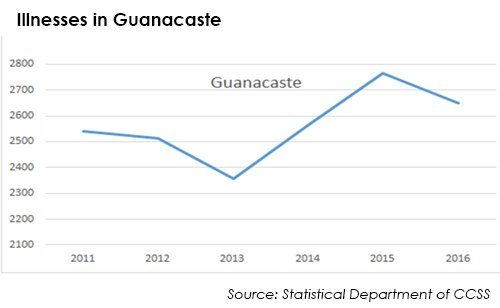
Illnesses like asthma, allergic conjunctivitis, the flu, rhinitis, and rotavirus increased an average of 5% between 2013 and 2016 in Guanacaste, according to an analysis of the Health Ministry’s statistics on acute upper respiratory illnesses (AURI) by The Voice of Guanacaste.
In 2011, 2,542 people were treated in the Caja for acute respiratory illnesses in Guanacaste. This number decreased by 27 in 2012 and 158 in 2013, but it increased every year after that until 2016.
There was a slight decrease in 2016, but that number was still greater than what it was in 2011.

According to Álvaro Méndez Solano, the head of Epidemiological Monitoring at Enrique Baltodano Hospital in Liberia, the seasonal flu virus has contributed to the increase.
“Oftentimes, AURI can be caused by a virus that’s going around like the flu. In November and December of last year we saw an increase in patient mortality,” said Méndez.
Other factors contributing to the increase in AURI in the province are people with heart problems, diabetes, obesity, or vulnerable populations like children between four and five years and the elderly, added Méndez.
Additionally, Méndez included dust particles inhaled by Guanacastecans as another factor that causes respiratory illnesses, especially in areas with gravel roads.
Vaccination Campaign
With the arrival of the first rains in Guanacaste, the Costa Rican Social Security Fund (in Spanish, CCSS) predicts an increase in AURI among the local populace.
It’s normal that the first rains bring about an increase in acute respiratory illnesses,” said Méndez.
The CCSS will begin a free vaccination campaign against influenza throughout the province next July 5-14.
“We’ll give vaccinations against influenza types A and B in all hospitals and Ebais in the province,” said Méndez.
The CCSS recommends to wash your hands frequently and cover your month with your forearm when you sneeze to avoid spreading these viruses.







Comments